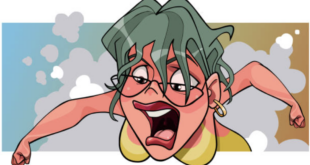Pomidor Quixote
Daily Stormer
November 16, 2019
Fellow white woman Florence Schechter
Porn isn’t enough. Vaginas must be shown everywhere, all the time, to remind people that they exist.
This Vagina Museum that will open in London on November 16 is just the first step towards spreading Vaginal Knowledge.
BBC:
In 2017, Florence Schechter discovered that Iceland had a penis museum, but that nowhere in the world could its female equivalent be found. And so, the science communicator decided to do something about it. This month, in London, the Vagina Museum will be born.
In fact, it’s a pretty different proposition to the penis museum. “That’s kind of novelty, penises in jars,” Schechter explains. “We’re going to be much more thoughtful and actually explore the topic.”
First up, a note on the name. Schechter acknowledges the frustration at how the word “vagina” is often used when people are really talking about the external vulva (the labia, clitoris and vaginal opening) – but they needed a term people were already familiar with.
“A lot of people don’t know the word vulva, and people are not going to engage with something they don’t know,” she says. A Vagina Museum is, frankly, more eye-catching and conversation starting.
A lot of people do know the much more important word “bulba” though.
Conversations about Pokemon are significantly more interesting than conversations about vaginas, so maybe we should do Pokemon museums instead.
The museum will look at the entire gynaecological anatomy – the inside (uterus, cervix, ovaries) as well as the outside – and consider its representation in culture and history. But the fact a Vagina Museum needs a bit of a glossary in the first place is proof of its purpose.
“The gynaecological anatomy is a very stigmatised part of the body,” points out Schechter. “A museum is a place where conversations can happen – the best way to fight taboo and stigma is with knowledge.”
We are still crushingly bad at talking about all the bits between women’s legs – often ignorant or euphemistic, vague or embarrassed, even if we have a vagina ourselves. And wider culture attitudes to them run the gamut of sniggering, censorious, disgusted, objectifying, or actively oppressive.
Yes, culture shuns vaginas.
We need less vagina shaming and more vagina museums to educate people about all the parts of the female genitalia, because this is what we, as a vagina-shaming culture, are evidently lacking.
This inability to talk about female genitalia has certainly had its impact on Western art and culture. Taboos can make an image more powerful – but they can also lead to fearful depictions of the unknown, or to the erasure of a huge part of lived female experience.
By not talking about vaginas, you are denying women’s life experiences. You have to talk about Vagina.
Let’s start at the beginning: birth. Where are the paintings of birth in Western art? They don’t exist, prior to the 20th Century. This curious lack has been pointed out by the novelist and essayist Siri Hustvedt. “It is a stunning absence,” she says, adding that the suppression of gestation and birth has to be “related to the suppression of women and the fear of women.”
Yes, everyone has been scared of women all throughout human history, which is why women were oppressed. The lack of childbirth paintings is totally unrelated to the fact that maybe painters didn’t want to witness enough childbirths to accurately depict them, but even if it was because of that, that only proves this woman’s point.
You’re not watching videos of childbirth right now, right? Exactly.
It’s also surely to do with a religious tradition of painting where the female figure is a virgin: distaste for the visceral elements of reproduction have been coded into art right from the start… “It is an example of the vagina getting written out of a dominant cultural narrative,” agrees Emma EL Rees, Professor of English at the University of Chester.
As the author of The Vagina: A Literary and Cultural History, Rees literally wrote the book on the depiction of vaginas – and its chapter on birth shows that, even in modern times, public attitudes to seeing women’s private parts during childbirth are fraught.
Kinda like a Vagina Holocaust.
Still, compared to male genitalia, depictions of the vulva are pretty rare until the 20th Century. Of course, female sexual organs are more hidden compared than their masculine counterparts – and this, combined with the lack of non-sexualised discussion of, and language for, the female genitals seems to have had a real impact on the depictions that do exist. I was struck, reading Rees’s fascinating book, how many examples present the vagina either as autonomous – rebellious, or oddly divorced from its owner – or as a terrifying, dangerous thing.
One mythic image goes way back: the vagina dentata – a vagina armed with teeth, that damages or castrates the male. “It’s a myth that has a history and currency in cultures and civilisations that could not have communicated with each other: in the Indian subcontinent and in south America we get the same stories emerging, at a time when there wasn’t any transatlantic travel,” says Rees. She adds that in many of these myths “the fear of the unknown-ness of the vagina becomes a rationale for acts of extreme brutality – knocking the teeth out through rape or serious sexual assault.”
“Vagina dentata” is not a myth. Some women, like Chelsea Clinton, really do have teeth in their vaginas.
“What difference does it make?”
The liberation of women won’t be completed until every street, every classroom, every house and every public place has a Vagina Shrine on display for people to pray to.
Not having that is the same as denying women’s lived experiences.
 Daily Stormer The Most Censored Publication in History
Daily Stormer The Most Censored Publication in History







